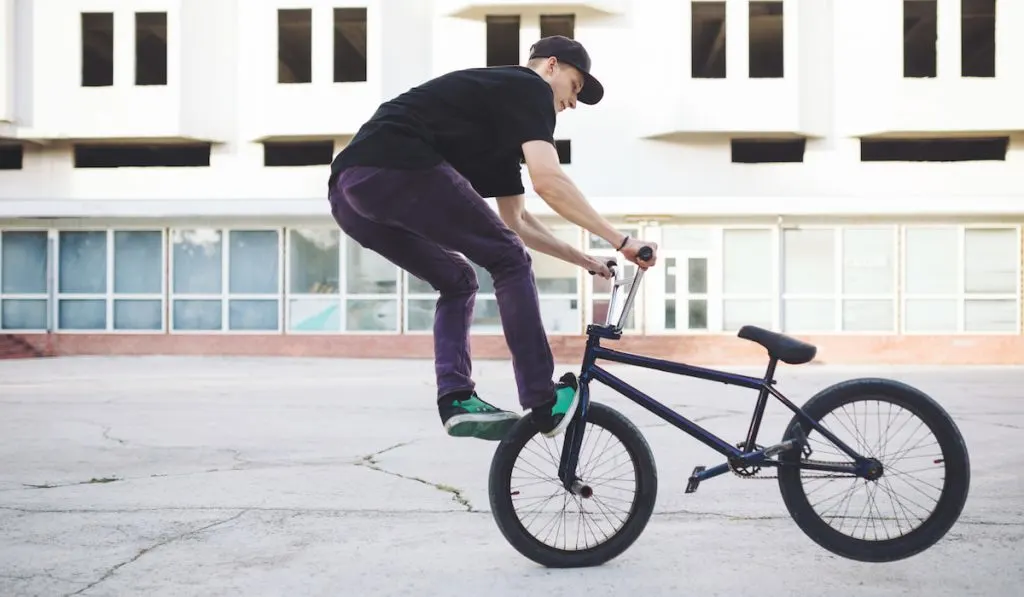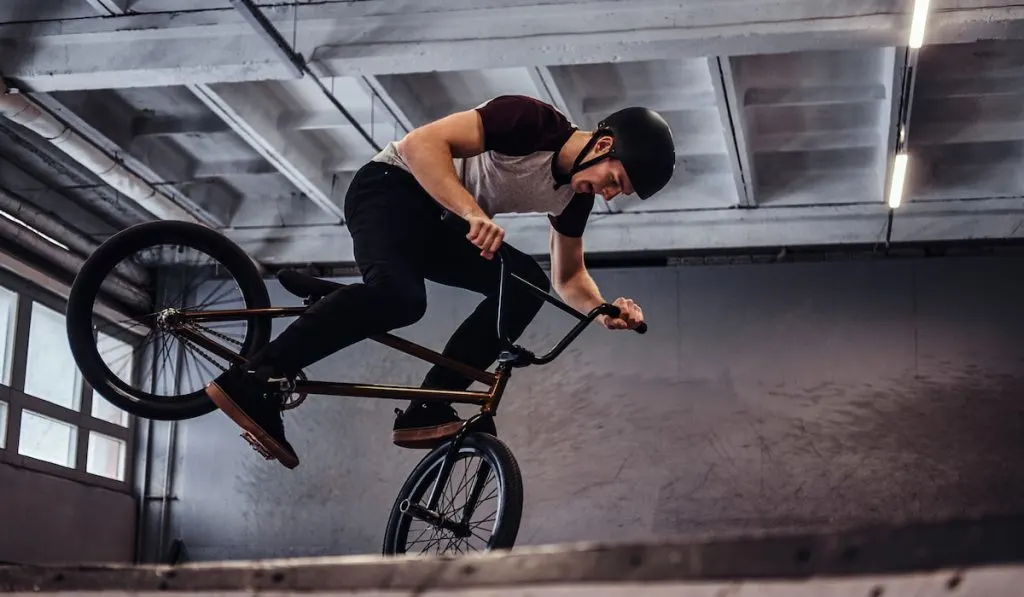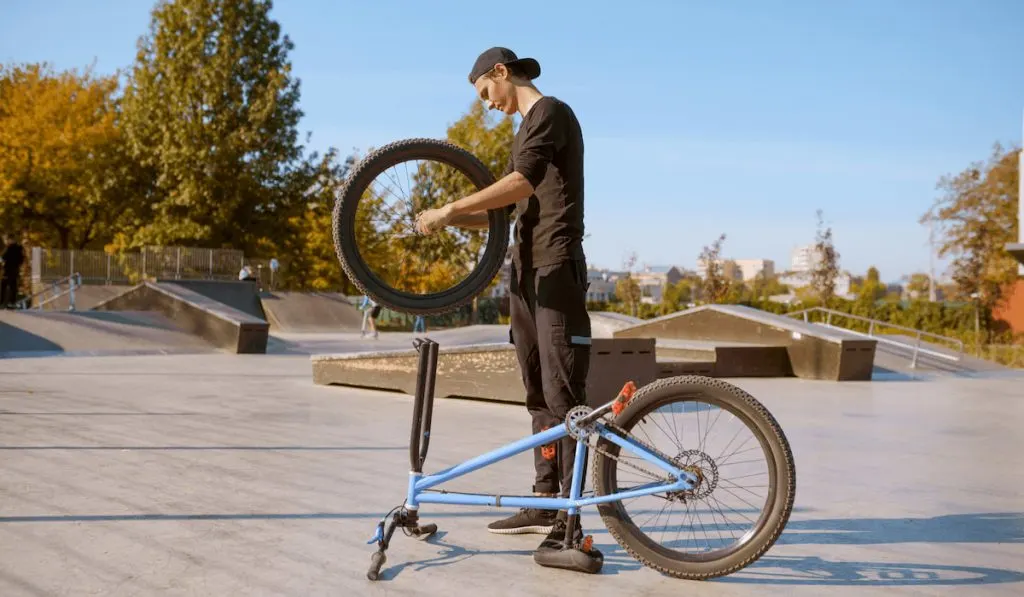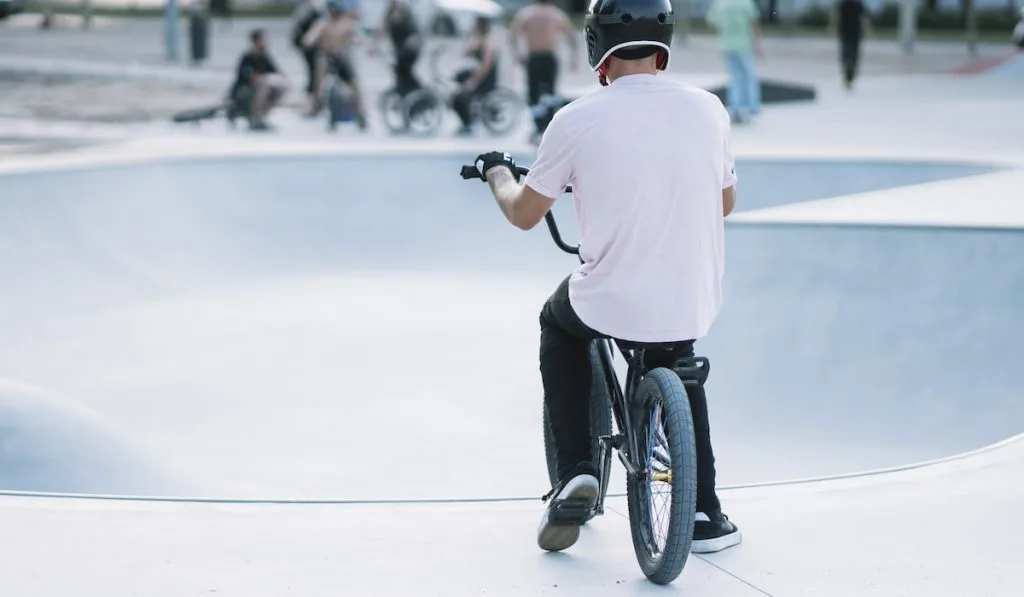Thinking about picking up BMX? First of all, welcome to the BMX community! It’s an amazing sport full of people trying to push themselves to do more tricks and move things forward.
Most people who start BMX or grow an interest in the sport first see it on TV or hear about it from friends. They see high-performance athletes doing some incredible tricks and want to give it a try.
Is it hard to ride a BMX? Well, yes and no. Riding a BMX is a lot like riding a bike. The seat typically rides lower, so it’s not something you’ll want to ride very long distances.
Riding a BMX bike around takes a bit more effort than a normal bike, so that’s something to keep in mind if you just like the look and want to use it for a get-around bicycle.
If you want to get started in BMX, here’s our complete beginner’s guide to getting you started.

What Is BMX?
BMX stands for Bicycle Motocross. There are generally two forms of official BMX sport – BMX racing and BMX freestyle.
With racing, riders of all ages participate in organized races with obstacles on a set course. Typically, races happen on dirt courses with things like jumps and sharp turns that require a varying level of skill.
In BMX freestyle, riders compete against each other one at a time on a track or course. They have a time limit in which they can ride up ramps, do tricks like flips and rail riding, and are then scored by judges.
BMX is often grouped in with other sports like skateboarding because, when not on the course, riders find curbs, ramps, railings, and other obstacles in parks and other areas where they can learn tricks and develop their routines.
The Difference Between BMX & Normal Bikes
BMX bikes look cool, but are they easy to ride? What’s the difference between a “normal” bike and a BMX bike? Let’s take a look.
Size Differences
First of all, BMX bikes are usually shorter than your typical bike. People sit lower to the wheels to give them more control and space as they go down ramps, do flips, and perform other tricks with their bikes.
These bikes are built for short bursts of speed on tracks or courses. Taking them on a long ride on a Saturday morning or getting them out on the trails with the mountain bikes isn’t the best idea.
Braking Systems
Most normal bikes have two brakes, one on each hand. BMX bikes typically only come with a single brake. This gives riders more control over stopping and starting, and it means less maintenance over the life of the bike.
No Suspension
BMX bikes usually don’t have any suspension. Riders stand when they are doing tricks or going down steps and let their bodies absorb the impact. You’ll be hard-pressed to find a suspension system on any BMX bike.
They are, however, built with strong materials and solid frames to withstand the beatings they go through performing jumps and other tricks.
A normal bike would break trying to do the same things without a serious suspension system.
No Gears
BMX bikes are often fixed-gear bikes. There are no 21-speed BMX bikes. The reason is that BMX bikes take a serious beating, and if they have fragile or sensitive components on them, they’re just going to break all the time. BMX bike builds are fairly simple.
The absence of a gear system can be a major issue if you live near or have to commute up some large hills every day.
You’ll have to pedal harder, and because you’re sitting lower it’s usually harder to generate a lot of force. You’ll be standing up a lot. On the bright side, it will be plenty of good exercise.

Are BMX Bikes Good for Beginners?
Yes, BMX bikes are great beginner bikes. Kids, in particular, have an easy time learning on BMX bikes because of the single break, no gears, and lower seat.
One of the things new bike riders struggle with is feeling like they are sitting too high off of the ground. With a BMX bike, the seat is much lower, so your feet are always close to the ground and can plant for stability when needed.
BMX bikes also often have thicker tires that provide more traction and stability. Finding balance is the biggest obstacle beginners face when learning to ride a bike, so the added width certainly helps.
BMX Gear & Accessories
With BMX, as with many other sports, you can spend a relatively affordable amount of money on the sport, but you can also end up spending a great deal of money as your passion for BMX grows.
Here’s a basic list of the gear you’ll need as well as some of the optional things you can add to your collection as you go.

Choosing a Bike
If you’ve got the money, you can easily spend thousands of dollars on a BMX bike. While prices of BMX bikes don’t usually compare to expensive road bikes where you can spend five figures on the latest carbon fiber models, higher-end BMX bikes will cost around a few thousand dollars.
Of course, if you’re new to BMX, you absolutely don’t need to buy the most expensive bike that you can find. A good bike will cost you anywhere from around $350-$1,000.
That’s a pretty big range, we know, but there are a lot of options you can choose from like seat material, different types of wheel tread, etc. Yes, there are BMX bikes out there for less than $100, which are fine for kids, but if you’re older and bigger, get something that’s higher-quality.
Buying a bike online is easier now than ever, and while the best deals are often found online, you should certainly ask for advice if you have any questions. Make sure you ask about what type of bike you should get and what skill level you are if you need some assistance.
Bike Fit – How to Make Sure the BMX Bike Is the Right Size
Bike fit is probably the most important thing you should focus on when you’re buying a bike. The right fit will make riding it around town or after school more comfortable, and it will make doing tricks come to you quicker.
How can you size a BMX bike if you’re buying it online? Below is a wheel size reference based on height that is a good place to start.
As you become more comfortable on your bike, you can adjust your seat height and other settings to make it work best for you.
(Source)
Buying Accessories
Kitting out your bike is one of the best things about BMX. Your bike quickly becomes an expression of what type of rider you are.
People love customizing their bikes, and a great thing about BMX bikes is that components come out easily and you can mix and match items based on your style preferences and what gets you around better.
Protective Gear

BMX is a rough sport where injuries are fairly common. You’re riding at high speeds and most of the obstacles you’re practicing on are made of wood, metal, or concrete. The stakes are high so you should take proper precautions with the appropriate safety gear.
Even the pros you see competing in the Olympics wear helmets. You might see people at your local skate park going without helmets, but it’s not a great idea, especially if you’re new to BMX.
A nice thing about buying a helmet, the right shoes, elbow guards, knee pads, and other protective gear is that they don’t need to be super aerodynamic like with road bikes. Not many BMXers are concerned with shaving milliseconds off the time it takes them to get up or down a ramp.
The main thing you should do when buying a helmet, pads, and other gear is to stick to well-known brands and read the reviews. You can find something with a good track record that looks cool and fits your budget.
Most of the gear is affordable enough that it’s no major pain to upgrade after using it for a year or two. At the very least, don’t spend a ton of cash on protective gear until you know it’s a sport you’re going to stick with long-term.

Performing a Safety Check Before You Ride
Riders of any level should conduct safety checks before they ride. If you’re a beginner, you’ll want to check the bike before you hop on to look for anything that will give you trouble. As you become more experienced as a rider, you’ll feel more confident hopping on and going.
However, if you’re ever going to attempt any tricks, you need to make sure your bike is in good shape. Here’s what you should check:
- Tire pressure – Your tires should have appropriate tire pressure to handle jumps and normal riding. They should feel firm to the touch with just a hint of give when you press down on them.
- Bike Chain – Your chain should be greased or oiled to avoid halting movement that causes it to derail.
- Check Brakes – Brakes should be custom fit to your desired sensitivity. Obviously, brakes that don’t work at all are big trouble, but tight brakes when you don’t expect them can send you flying over the handlebars.
- Pedals – Check that the pedals are on securely. You don’t want to stand up and crank down on the pedals only to have one fall or break off.

Get Out There and Ride
BMX is a great sport with a supportive community full of passionate riders.
You’re sure to find friends and mentors along the way. Just get out there and ride! There are terrific, affordable bikes for beginners, and you can customize and upgrade them as you go.
